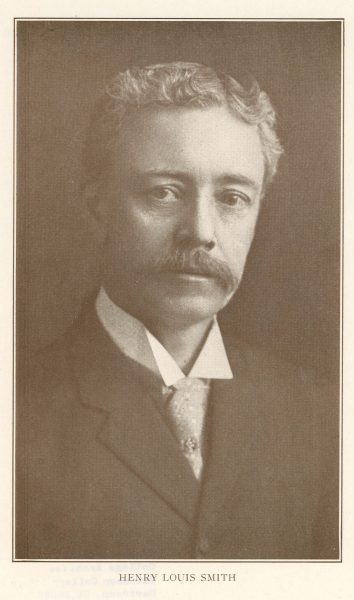DAVIDSON HISTORY
The Indefatigable Henry Louis Smith

Henry Louis Smith, scientist, public figure, and Davidson President (photo courtesy of Davidson College Archives)
In 1887, Davidson College hired Henry Louis Smith, one of its 1881 graduates, as professor of natural sciences (physics and astronomy). He was to become what Winston-Salem’s Western Sentinel described in 1893 as “that well beloved professor, that strong pillar and never-tiring worker.” So energetic was he that Davidson students came to call him “Project” for the many innovations he brought to the college.
Smith was born in Greensboro in 1859, and graduated from Davidson, where he excelled, in 1881. He was not only active in the classroom but felt that outdoor activity and sports led to a sound mind. As a youth, he had been involved in baseball, swimming, fishing, camping, and canoeing, and at Davidson he was a shortstop on the college baseball team and participated in skating and boxing. All this while winning gold medals in Greek, math, and the English essay. After graduating he spent five years as the first principal of the Selma Academy in Selma, North Carolina. The academy, founded by John A. Waddell in 1880, was extremely successful under his direction, and by the time he left, enrollment stood at 100, with students coming from surrounding counties.
In 1886, Davidson College asked him to come as professor of natural sciences, but he requested a year’s leave to do graduate work at the University of Virginia, which awarded him an MA in 1887. He then began his career at Davidson, taking a leave again around 1890 to pursue his Ph.D. at University of Virginia. He was apparently an inspirational teacher. In 1915 the biographical publication Makers of America declared: “it may be said that Dr. Smith is one of the leaders in that new and progressive group of teachers…whose spiritual and intellectual vision sees…the larger horizon of life which bounds every duty owed by man to his fellow-man, and every opportunity for the advancement of the human race.”
Dr. Smith was also active outside the classroom. In keeping with his belief in physical activity, in 1886, he visited Presbyterian churches across North Carolina to raise funds for a new college gymnasium. In 1889, he spearheaded the effort to open a skating rink on the top floor of one of the stores in Davidson. He was also the impetus behind the construction of Lake Wiley on the college campus in 1893. In 1895, he toured Europe on a bicycle.
In addition, he was engaged in the broader community. He was a member of the board of commissioners, and by 1890 was its Sanitary Commissioner. That same year, he was one of the original members of the board of directors of the Linden Manufacturing Company, which built the first cotton mill in Davidson. He was also active in the Y.M.C.A. and the state teachers association. On March 27, 1890, the Western Sentinel described Smith, one of the younger officers of Linden Manufacturing, as “full of energy,” noting that he “was elected President of the Teachers’ Assembly at Morehead City last summer and is some “big officer” in the Y.M.C.A., now President of the Liden (sic) Manufacturing Co., and may yet be President of the U.S.! Well, if he ever is, he will fill the place with pleasure to himself and honor to the country.”
Smith kept up with his scientific studies. During the summers of 1893 and 1894, he pursued further studies at Cornell and Harvard universities. In February 1896, Smith and his students conducted what the Wilson Times called “the first experiment with the Roentgen photographic process in the South” when they used a Roentgen ray or X-ray to detect a bullet in the hand of a cadaver.
In 1896, Dr. Smith married Julia Lorraine DuPuy, daughter of Davidson physician John James DuPuy. They were to have eight children. That same year he was named Vice President of Davidson College. He was also a popular speaker, travelling North Carolina to speak on various topics. Following an 1897 speech about his bicycle trip across Europe, Lumberton’s Robesonian described him as “a splendid speaker, fresh in thought and clear in statement, making it always a pleasure and often a delight to listen to him.”
In 1901, Dr. Smith became president of Davidson College, the first president not to be an ordained Presbyterian minister. During his tenure, enrollment tripled, the faculty and plant grew, and the endowment increased. He also developed an interest in fruit growing and applying scientific principles to the management of orchards, and his Brushmont Orchard in Alexander County won national prizes.
In 1912, Dr. Smith left Davidson to be the president of Washington and Lee College in Virginia, where he had similar success. Near the end of World War I, President Woodrow Wilson offered a prize to anyone devising a scheme to inform the German people of his peace plans. Smith won the prize with a method of attaching a message to small gas-filled balloons, which were released in France where the prevailing winds would carry them to Germany. His novel idea is credited with shortening the war.
After 17 years at Washington and Lee, Henry Louis Smith retired to Greensboro, where he published a regular column called “Science and Our World” in the local newspaper. In 1947, he published a collection of his essays and speeches titled This Troubled Country. He died in Greensboro in February 1951.
Nancy Griffith
Nancy Griffith lived in Davidson from 1979 until 1989. She is the author of numerous books and articles on Arkansas and South Carolina history. She is the author of "Ada Jenkins: The Heart of the Matter," a history of the Ada Jenkins school and center.


